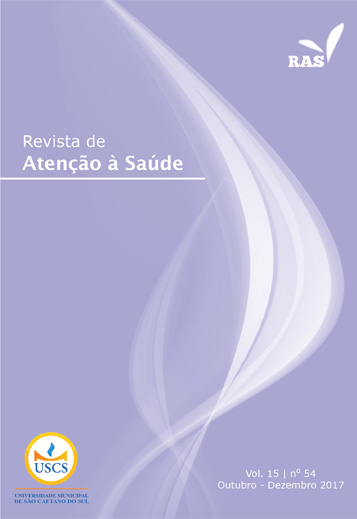TRANSCUTANEOUS ELECTRICAL NERVE STIMULATION IN PRIMARY DYSMENORRHEA IN YOUNG WOMEN
DOI:
https://doi.org/10.13037/ras.vol15n54.4824Keywords:
Dysmenorrhea, transcutaneous electrical nerve stimulation, visual analog scale, pain measurementAbstract
Introduction: Dysmenorrhea is characterized by abdominopelvic pain before or during menstruation. Cyclic pain that may be accompanied by headache, vomiting, dizziness, bloating, and other symptoms. Objective: To evaluate the transcutaneous electrical nerve stimulation (TENS) analgesic effect for primary dysmenorrhea in young nulliparous women. Methods: The study included twenty volunteers, aged 18 to 26 years. The participants were randomized in two groups: placebo group (PG, n=10) and treatment group (TG, n=10). Pain assessment was performed by the visual analog scale (VAS) and the McGill pain questionnaire. The daily procedure was 30 minutes duration, frequency of 100Hz and pulse duration 200µs, strong intensity, but comfortable. Results: The mean reduction in pain levels were higher for TG, but for both groups they were significantly reduced. Conclusion: The TENS was effective in treating pain caused by primary dysmenorrhea in young nulliparous women, but only slightly different from placebo.Downloads
References
Osayande AS, Mehulic S. Diagnosis and initial management of dysmenorrhea. Am Fam Physician. 2014;89(5):341–6.
Peruzzo BCT, Ramalho LS, Figueiredo MR, Alfieri FM. Benefícios sobre a intensidade da dor, qualidade de vida e incapacidade de mulheres com dismenorreia subemetidas a exercícios gerais versus método Pilates: estudo-piloto. ABCS Heal Sci. 2015;40(1):6–10.
Iacovides S, Avidon I, Baker FC. What we know about primary dysmenorrhea today: A critical review. Hum Reprod Updat. 2015;21(6):762–78.
Ju H, Jones M, Mishra G. The prevalence and risk factors of dysmenorrhea. Epidemiol Rev. 2014;36(1):104–13.
Kannan P, Claydon LS. Some physiotherapy treatments may relieve menstrual pain in women with primary dysmenorrhea: A systematic review. J Physiother. 2014;60(1):13–21.
Ortiz MI, Cortés-Márquez SK, Romero-Quezada LC, Murguía-Cánovas G, Jaramillo-Díaz AP. Effect of a physiotherapy program in women with primary dysmenorrhea. Eur J Obs Gynecol Reprod Biol. 2015;194:24–9.
Gerzson LR, Padilha JF, Braz MM, Gasparetto A. Physiotherapy in primary dysmenorrhea: literature review. Rev Dor. 2014;15(4):290–5.
Claydon LS, Chesterton LS, Barlas P, Sim J. Dose-specific effects of transcutaneous electrical nerve stimulation (TENS) on experimental pain. A systematic review. Clin J Pain. 2011;27(7):635–47.
Doucet BM, Lam A, Griffin L. Neuromuscular electrical stimulation for skeletal muscle function. Yale J Biol Med. 2012;85(2012):201–15.
Pimenta CA de M, Teixeira MJ. Questionário de dor McGill: proposta de adaptação para a língua portuguesa. Rev Bras Anestesiol. 1997;47(2):177–86.
Balbi C, Musone R, Menditto A, Di Prisco L, Cassese E, D’Ajello M, et al. Influence of menstrual factors and dietary habits on menstrual pain in adolescence age. Eur J Obs Gynecol Reprod Biol. 2000;91(2):143–8.
Nunes JMO, Rodrigues JA, Moura MSF, Batista SRC, Coutinho SKSF, Hazime FA, et al. Prevalence of dysmenorrhea in university students and its relation to school absenteism, physical exercise and use of medicines. Rev Bras Promoc Saude. 2013;26(3):374–9.
Chen CX, Kwekkeboom KL, Ward SE. Self-report pain and symptom measures for primary dysmenorrhoea: A critical review. Eur J Pain. 2015;19(3):377–91.
Milsom I, Hedner N, Mannheimer C. A comparative study of the effect of high-intensity transcutaneous nerve stimulation and oral naproxen on intrauterine pressure and menstrual pain in patients with primary dysmenorrhea. Am J Obs Gynecol. 1994;170(1 Pt 1):123–9.
Oliveira RGCQ De, Silva JC, Almeida AF De, Araújo RC De, Pitangui ACR. TENS de alta e baixa frequência para dismenorreia primária: estudo preliminar. ConscienteiaSaude. 2012;11(1):149–58.
Lundeberg T, Bondesson L, Lundstrom V. Relief of primary dysmenorrhea by transcutaneous electrical nerve stimulation. Acta Obs Gynecol Scand. 1985;64(6):491–7.
Wang S-F, Lee J-P, Hwa H-L. Effect of transcutaneous electrical nerve stimulation on primary dysmenorrhea. Neuromodulation. 2009;12(4):302–9.
Lauretti GR, Oliveira R, Parada F, Mattos AL. The new portable transcutaneous electrical nerve stimulation device was efficacious in the control of primary dysmenorrhea cramp pain. Neuromodulation. 2015;18(6):522–7.
Lee B, Hwa S, Kim K, Chang W, Hong J, Ryeol J, et al. Efficacy of the device combining high-frequency transcutaneous electrical nerve stimulation and thermotherapy for relieving primary dysmenorrhea: a randomized, single-blind, placebo-controlled trial. Eur J Obs Gynecol Reprod Biol. 2015;194:58–63.
Rocha MG, Coelho R. Placebo - compreender a cura pelo nada. Rev Port Psicossomática. 2003;5(2):141–54.
Downloads
Published
Issue
Section
License
Policy Proposal for Journals offering Free Delayed Access
Authors who publish in this magazine agree to the following terms:
- Authors maintain the copyright and grant the journal the right to the first publication, with the work simultaneously licensed under a Creative Commons Attribution License after publication, allowing the sharing of the work with recognition of the authorship of the work and initial publication in this journal.
- Authors are authorized to assume additional contracts separately, for non-exclusive distribution of the version of the work published in this magazine (eg, publishing in institutional repository or as a book chapter), with the acknowledgment of the authorship and initial publication in this journal.
- Authors are allowed and encouraged to publish and distribute their work online (eg in institutional repositories or on their personal page) at any point before or during the editorial process, as this can generate productive changes, as well as increase impact and citation of the published work (See The Effect of Open Access).









